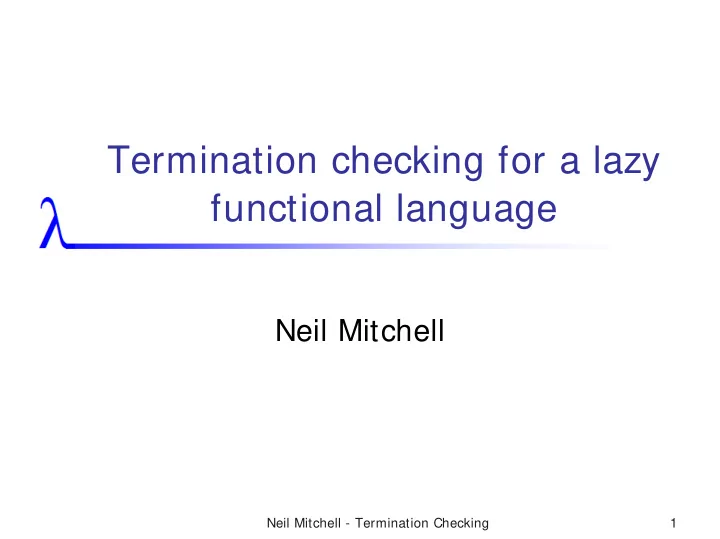

Termination checking for a lazy functional language Neil Mitchell Neil Mitchell - Termination Checking 1
Overview � Background � Properties of functional languages � Bottom ⊥ , Lazy, Higher order… � Total programming � Sized Types � Termination Checkers � Open questions Neil Mitchell - Termination Checking 2
Bottom ⊥ head [1,2,3] = 1 head [] = ⊥ Not case complete – unspecified in some situations sum [1..10] = 55 sum [1..] = ⊥ Never terminates, no error returned Neil Mitchell - Termination Checking 3
Laziness What is the result of head [1..] ? Strict: ⊥ Eager languages, C, ML, Scheme Lazy: 1 Haskell, Clean take 10 primes Neil Mitchell - Termination Checking 4
Higher Order � Can pass a function as a value � Possible to define a function apply such that: sum = apply add product = apply multiply apply f [x] = x apply f (x:xs) = f x (apply f xs) Neil Mitchell - Termination Checking 5
Total Functional Programming Turner 1995, 2004 - of SASL, KRC, Miranda � Functional programming without ⊥ � Can't crash (case complete) � Can't loop forever (…unproductively) � Requires syntactic descent fact 0 = 1 fact (x+1) = (x+1) * fact x Neil Mitchell - Termination Checking 6
Infinite and Total? Telford and Turner 1997, 2000 � Useful for � Infinite lists – the list of primes � Reactive systems – embedded systems � Stream processing � Use codata instead of data � Keep codata and data separate � Must be productive � Must generate next element in finite time � But can continually generate next elem Neil Mitchell - Termination Checking 7
The Downside � But total functional programming is not all good… � Not Turing Complete � Requires substantial rewrites to code � Natural definitions are not correct � Need map and comap � Can't have head first_even = head evens Neil Mitchell - Termination Checking 8
Head v2.0 head [] = error "No head!" head (x:xs) = x head [] = Nothing head (x:xs) = Just x head a [] = a head a (x:xs) = x head no yes [] = no head no yes (x:xs) = yes x Neil Mitchell - Termination Checking 9
Sized Types Hughes et al. 1996; Pareto 1998; Abel 2003 � Annotate type signatures with size � Numbers become lists � Use succ(x) and zero – Peano numbers � 4 = succ(succ(succ(succ(zero)))) append :: [x] -> [x] -> [x] append :: a -> b -> a + b Used to prove termination and productivity, composes upwards Neil Mitchell - Termination Checking 10
Sized Types - Sorting isort [] = [] isort (x:xs) = insert x (isort xs) insert n [] = [n] insert n (x:xs) = if if n<=x then then n: x: xs else else x: insert n xs isort :: n -> n insert :: _ -> n -> n + 1 Neil Mitchell - Termination Checking 11
Sized Types – Sorting (2) qsort [] = [] qsort (x:xs) = qsort l++[x]++qsort h where l = filter (<= x) xs h = filter (> x) xs filter :: _ -> n -> n or ≤ n qsort :: n -> ? l / h :: n – 1 qsort :: n -> n 2 qsort :: n -> w Neil Mitchell - Termination Checking 12
Termination Checkers Higher Order Abel 1998 Turner 2004 Telford, Turner 2000 Pientka 2004 Panitz 1996 Thiemann, Panitz 1998 Giesl 2003 Giesl, Arts 2001 Glenstrup 1999 Brauburger, Giesl 1998 Lazy Case incom plete Neil Mitchell - Termination Checking 13
Prolog termination checkers Genaim, Codish 2001; Apt, Pedreschi 1993; Lindenstrauss, Sagiv 1997; Verbaeten et al 1991; lots more � Properties of Prolog… � Definitely case incomplete � Higher order (using call ) Naish 96 � Lazy? � Backtracking has similarities � Can encode laziness in Prolog Antoy, Hanus 2000 Neil Mitchell - Termination Checking 14
Prolog termination checkers (2) � Lots of different methods � Most rely on building up an ordering over some term � Some use constraint solvers � Tabling, time complexity… � There is a set of standard problems from various papers � Parsing, Ackermann, sort, reverse, greatest common divisor etc. � No solver gets them all! Neil Mitchell - Termination Checking 15
Panitz 1998: TEA � Translate to a Core language � Use Tableau proof � Like case analysis � Variable a is either Nil, or Cons � Looks for orderings on variables � Errors as 'successful termination' � '90%' successful Neil Mitchell - Termination Checking 16
Normal Form (nf) Termination � An expression is in normal form if it cannot be reduced any further � [1..] does not have a normal form � f a b c is nf-terminating if � Given a , b and c are in normal form � f a b c will reduce to normal form � Proves nothing about head [1..] Neil Mitchell - Termination Checking 17
Example: sum sum Nil = 0 sum (Cons x xs) = x + sum xs sum T T = Nil T = Cons T 1 T 2 0 T 1 + sum T 2 T > T 2 Cons T 1 T 2 > T 2 Cons a b = 1 + b Neil Mitchell - Termination Checking 18
Open Questions � Would a termination checker be used? � Maybe as part of a compiler? � Maybe for high quality code? � How much code rewrite is acceptable? � None? � Just restricted to library functions? Neil Mitchell - Termination Checking 19
Summary � Properties of functional languages � Bottom ⊥ , Lazy, Higher order � Total programming � No ⊥ , codata � Sized Types � Extension of type system with size � Termination Checkers � Prolog checkers � TEA: Haskell checker Neil Mitchell - Termination Checking 20
Recommend
More recommend